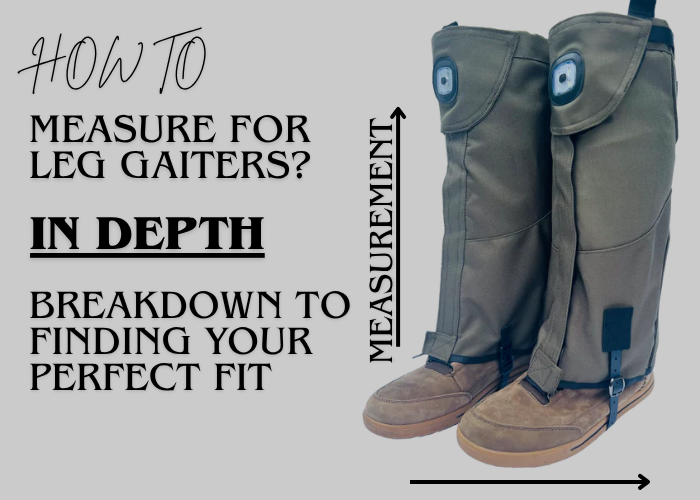Leg gaiters (sometimes called leg gaiters, gaiters, or simply “gaiters”) are invaluable gear for hikers, hunters, outdoor workers, or anyone traversing rough terrain, marshes, snow, brush, or snake-inhabited areas. Their job is to seal the gap between your boots and your lower pants leg—preventing debris, water, insects, or even snake strikes from entering.
However, poorly fitting gaiters can defeat that very purpose: too loose and things sneak in, too tight and they’re uncomfortable or restrict movement. That’s why measuring carefully is crucial before purchasing. Below is a step-by-step guide, tips, and common pitfalls to avoid.

Why Accurate Measurements Matter
-
Seal & protection: A good fit ensures coverage around the boot and snug contact with your leg, forming an effective barrier against debris, water, or snake strikes.
-
Comfort & mobility: Gaiters that are too tight can chafe or restrict circulation; ones too loose may flap, shift, or allow ingress.
-
Longevity of gear: Proper fit reduces stress on seams, closures, and straps, making gear last longer.
-
Compatibility with boots & pants: Your boots’ height, volume, and pant thickness influence the fit; you must measure in the gear combinations you intend to use.
What Measurements You’ll Need
Here are the typical dimensions that gaiter manufacturers ask for (or that help you choose a correct size):
|
Measurement |
What to Measure / How |
Why It Matters |
|
1. Calf circumference |
Measure around the largest part of your calf (over your hiking pants or trousers) |
This determines how snugly the gaiter will wrap around your lower leg. |
|
2. Boot (ankle) circumference / instep width |
Measure just above the ankle, around the boot’s upper (or the area the bottom of the gaiter will meet) |
Ensures the gaiter can close or seal properly around the boot. |
|
3. Gaiter height (leg length) |
Measure from a reference point (often from just above the boot to a point on your leg) to where the gaiter’s top will rest |
Helps you pick the right height (short, mid, knee) for coverage and mobility. |
|
4. Distance between calf and boot (optional) |
Some sizing charts consider the vertical offset between the calf’s widest part and the boot top. |
Useful if your leg shape is unusual or gear is tight. |
Tips for Taking Measurements
-
Wear the hiking pants or trousers you will use with the gaiters when measuring, so you capture realistic bulk.
-
Use a soft measuring tape (tailor’s tape).
-
Stand naturally (don’t flex muscles) and keep your weight evenly distributed.
-
If you’re between sizes, pick the larger (if the gaiter offers adjustment) rather than too snug.
-
Some manufacturers require left vs. right calf measurement if your legs differ slightly (rare, but worth checking).
Step-by-Step: How to Measure for Leg Gaiters
Here is a detailed walk-through:
-
Put on your hiking pants/trousers and boots
Wear exactly what you’ll use in the field, since pant thickness and boot bulk affect measurements.
-
Measure calf circumference
Wrap the tape around the widest part of your calf (usually mid-calf) over the pants. Record that in centimeters or inches.
-
Measure boot circumference / instep area
Wrap the tape around just above the top of your boot (where the gaiter’s lower edge will lie). Also measure across the instep width (from side to side) when needed.
-
Measure gaiter height / leg length
Decide where your gaiter will start (just above boot) and where it will end (mid-calf, bottom of knee, etc.). Measure vertically along the leg surface between those points.
-
(Optional) Measure offset between calf and boot
If your calf bulges out significantly above the boot, measure the vertical distance from boot top to the calf’s widest point. This can help some sizing charts.
-
Compare with product sizes
Look at the manufacturer’s sizing chart or product details. For example, Nighthawk’s “Leg Gaiters for Hiking” or “Trailblazer Waterproof Gaiters” pages (on your site) should list recommended calf widths and heights.
-
Allow for adjustability margin
Most gaiters have hook-and-loop, drawcords, elastic or buckles to adjust fit. Ensure the size you choose falls comfortably within that adjustable range.
Choosing the Right Gaiter Height & Style
Your measurement gives you dimensions, but you must also pick the height and type of gaiter that suits your needs:
-
Over-the-ankle / low gaiters: Offer minimal height (just around the ankle). Best for light trail runs, gravel paths, or mild conditions.
-
Mid-calf gaiters: Provide more protection for brush, mud, or wet trails.
-
Knee (full-length) gaiters: Height around 15–18 inches, ideal for snow, wet brush, or deeper cover.
Your measuring of height helps decide which style to buy. For example, for deep brush or snow, use a knee-length gaiter; for dry rocky trails, mid-height may suffice.
Common Mistakes & How to Avoid Them
|
Mistake |
Consequence |
How to Avoid |
|
Measuring without boots or pants |
Underestimates bulk, giving a too tight fit |
Always measure with the actual gear you’ll wear |
|
Over-tight measurements |
Gaiters become uncomfortable, restrict movement |
Give a little breathing room, especially if muscle flex or swelling is expected |
|
Picking a size too small because “it looks better” |
Gaiter flaps, shifts or lets debris in |
Use sizing charts and stay within recommended adjustment range |
|
Ignoring product-specific instructions |
Different gaiters use varying closure styles or cut |
Always check the product’s own sizing guide or notes |
|
Forgetting to consider boot type |
Mountaineering boots are bulkier than hiking boots |
Use boots you’ll be using and check how size aligns with them |
Putting It All Together: Example Scenario
Let’s say you’re preparing for a trek in mixed terrain with occasional snow patches. You plan to use a pair of mid-height waterproof gaiters (knee-length too heavy). Here’s how you’d proceed:
-
Wear your hiking boots + the pants you’ll use.
-
Measure calf circumference: 38 cm (over pants)
-
Measure boot circumference: 30 cm just above boot collar
-
Measure height from boot top to a point just below the knee: 35 cm
-
Check the product table for, say, Trailblazer Waterproof Gaiters: maybe size “M” fits calf 36–40 cm and supports heights of 32–37 cm.
-
Confirm your measurements are within that size’s adjustability (e.g. ± 1 cm).
-
Order that size and test fit once it arrives (wear it with boots and move around) before heading into the field.
Final Checklist
-
Wear boots and pants when measuring
-
Use soft tape at the calf’s widest point
-
Measure boot/instep area
-
Measure gaiter height
-
Compare to manufacturer’s sizing chart
-
Ensure your measurements fall within the adjustment margins
-
Consider gaiter height (low, mid, knee) relative to your terrain and needs
- Test the fit before a big outing


Share:
What to Wear to Avoid a Snake Bite
How to Stay Safe from Snakes While Hiking or Hunting